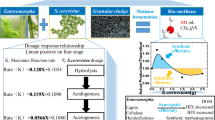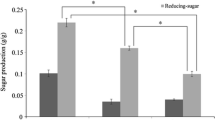Abstract
In the city of Ulsan, South Korea, Food-Waste Leachate (FWL) is let off into the ocean, which eventually poses a severe threat to the marine environment. Preliminary results suggest that this leachate, when subjected to an optimized fermentation process can generate ethanol. A 23-factorial design was employed, and the effects of temperature (30-40°C), pH (4–6), and reducing sugar concentration (RSC, 45–75 g L−1) on ethanol yield was investigated through controlled batch experiments using Saccharomyces cerevisiae (KCTC-7904), a species of budding yeast. A maximum yield of 0.31 g ethanol g−1 RSC corresponding to an ethanol concentration of 23.56 g L−1 was achieved under the following test conditions: temperature − 40°C, pH − 4.0, and RSC − 75 g L−1. Among the different parameters studied, both temperature and RSC had a strong synergistic effect on ethanol yield, while the effects due to changes in pH values were minimal. Anew, under the test conditions, the 2-way interaction effect between temperature × pH and the 3-way interaction between temperature × pH × RSC were negative, while all other interactions, were positive and also found to be statistically significant at 5% probability (p value < 0.05). The results were represented by a suitable model equation, which could be easily applied for scale-up to produce value-added ethanol, by sterilizing FWL prior to fermentation. The practical implications of this research have been stated.
Similar content being viewed by others
References
APHA (1998). Standard methods for examination of water and wastewater, American Public Health Association, Washington, D.C.
Bai, F. W., Anderson, W. A., and Young, M. M. (2007). “Ethanol fermentation technologies from sugar and starch feedstocks.” Biotechnol. Adv., Vol. 26, No. 1, pp. 89–105.
Beney, L., Marechal, P. A., and Gervais, P. (2001). “Coupling effects of osmotic pressure and temperature on the viability of Saccharomyces cerevisiae.” Appl. Microbiol. Biotechnol., Vol. 56, Nos. 3–4, pp. 513–516.
Blue Flint. (2009). http://www.blueflintethanol.com/data/upfiles/project/UsingWasteHeat.pdf (February 2, 2010).
Cazetta, M. L., Celligoi, M. A. P. C., Buzato, J. B., and Scarmino, I. S. (2007). “Fermentation of molasses by Zymomonas mobilis: Effects of temperature and sugar concentration on ethanol production.” Bioresource Technol., Vol. 98, No. 15, pp. 2824–2828.
Deshpande, V., Raman, H. S., and Rao, M. (1983). “Simultaneous saccharification and fermentation of cellulose to ethanol using Penicillium funiculosum cellulase and free or immobilized Saccharomycesuvarum cells.” Biotechnol. Bioeng., Vol. 25, No. 6, pp. 1679–1684.
Douglas, C. M. (2001). Design and analysis of experiments, John Wiley & Sons Inc, Arizona.
Ebrahimi, F., Khanahmadi, M., Roodpeyma, S., and Taherzadeh, M. J. (2007). “Ethanol production from bread residues.” Biomass Bioenerg., Vol. 32, No. 4, pp. 333–337.
Edgardo, A., Carolina, P., Manuel, R., Juanita, F., and Baeza, J. (2008). “Selection of thermotolerant yeast strains Saccharomyces cerevisiae for bioethanol production.” Enzyme Microb. Technol., Vol. 43, No. 2, pp. 120–123.
Garda, J., Macedo, R. M., Faria, R., Bernd, L., Dors, G. C., and Furlong, E. B. (2005). “Alcoholic fermentation effects on malt spiked with trichothecenes.” Food Control, Vol. 16, No. 5, pp. 423–428.
Gaspar, M., Kalman, G., and Reczey, K. (2007). “Corn fiber as a raw material for hemicellulose and ethanol production.” Process Biochem., Vol. 42, No. 7, pp. 1135–1139.
Gopal, M., Pakshirajan, K., and Swaminathan, T. (2002). “Heavy metal removal by biosorption using Phanerochaete chrysosporium.” Appl. Biochem. Biotechnol., Vol. 102, Nos. 1–6, pp. 227–237.
ISI (2009). Industrial Symbiosis Institute, Kalundborg, http://www.symbiosis.dk/media/7940/symbiosis%20paper%20presentation.pdf (October 2, 2009).
Kádár, Z., Szengyel, Z., and Reczey, K. (2004). “Simultaneous Saccharification and Fermentation (SSF) of industrial wastes for the production of ethanol.” Ind. Crop. Prod., Vol. 20, No. 1, pp. 103–110.
Khuri, A. I. and Cornell, J. A. (1996). Response surface: Design and analysis, Marcel Dekker, New York.
Krishna, S. H., Chowdary, G. V., Reddy, D. S., and Ayyanna, C. (1999). “Simultaneous saccharification and fermentation of pretreated Antigonum leptopus (Linn) leaves to ethanol.” J. Chem. Technol. Biotechnol., Vol. 74, No. 11, pp. 1055–1060.
Le Man, H., Behera, S. K., and Park, H. S. (2010). “Optimization of operational parameters for ethanol production from Korean food waste leachate.” Int. J. Environ. Sci. Technol., Vol. 7, No. 1, pp. 157–164.
Lee, D. H., Behera, S. K., Won, J. W., and Park, H. S. (2009). “Methane production potential of leachate generated from Korean food-waste recycling facilities: A lab-scale study.” Waste Manage., Vol. 29, No. 2, pp. 876–882.
Miller, G. L. (1959). “Use of DNS reagent for determination of reducing sugars.” Anal. Chem., Vol. 31, pp. 426–428.
MOE (2005). The status of waste generation and treatment all over the country in Korea, Ministry of Environment, South Korea.
MOE (2009). Ministry of Environment, South Korea, http://eng.me.go.kr/docs/sub2/policy_view.html?idx=44&class=12&topmenu=B&cat=230 (September 15, 2009).
Nahvi, I., Emtiaxi, G., and Alkabi, L. (2002). “Isolation of a flocculating Saccharomyces cerevisiae and investigation of its performance in the fermentation of beet molasses to ethanol.” Biomass Bioenerg., Vol. 23, No. 6, pp. 481–486.
Ozmihci, S. and Kargi, F. (2007). “Effects of feed sugar concentration on continuous ethanol fermentation of cheese whey powder solution (CWP).” Enzyme Microb. Technol., Vol. 41, Nos. 6–7, pp. 876–880.
Pakshirajan, K. and Swaminathan, T. (2009). “Biosorption of lead, copper and cadmium by Phanerochaete chrysosporium in ternary metal mixtures: Statistical analysis of individual and interaction effects.” Appl. Biochem. Biotechnol., Vol. 158, No. 2, pp. 457–469.
Phisalaphong, M., Srirattana, N., and Tanthapanichakoon, W. (2005). “Mathematical modeling to investigate temperature effect on kinetic parameters of ethanol fermentation.” Biochem. Eng. J., Vol. 28, No. 1, pp. 36–43.
Qureshi, N., Dien, B. S., Nichols, N. N., Saha, B. C., and Cotta, M. A. (2006). “Genetically engineered Escherichia coli for ethanol production from Xylose: Substrate and product inhibition and kinetic parameters.” Food Bioprod. Process., Vol. 84, No. 2, pp. 114–122.
Seki, Y., Seyhan, S., and Yurdakoc, M. (2006). “Removal of boron from aqueous solution by adsorption on Al2O3 based materials using full factorial design.” J. Hazard. Mater., Vol. B138, No. 1, pp. 60–66.
Sharma, S. K., Kalra, K. L., and Grewal, H. S. (2002). “Fermentation of enzymatically saccharified sunflower stalks for ethanol production and its scale up.” Bioresource Technol., Vol. 85, No. 1, pp. 31–33.
Tang, Y. Q., Koike, Y., Liu, K., An, M. Z., Morimura, S., Wu, X. L., and Kida, K. (2008). “Ethanol production from kitchen waste using the flocculating yeast Saccharomyces cerevisiae strain KF - 7.” Biomass Bioenerg., Vol. 32, No. 11, pp. 1037–1045.
Ueno, R., Urano, N., and Kimura, S. (2002). “Effect of temperature and cell density on ethanol fermentation by a thermotolerant aquatic yeast strain isolated from a hot spring environment.” Fisheries Sci., Vol. 68, No. 3, pp. 571–578.
Vogel, H. C. and Todaro, C. L. (1996). Fermentation and biochemical engineering handbook, West wood, New Jersey.
Wang. Q., Ma, H., Xu, W., Gong, L., Zhang, W., and Zou, D. (2008). “Ethanol production from kitchen garbage using response surface methodology.” Biochem. Eng. J., Vol. 39, No. 3, pp. 604–610.
Wei, C. J., Tanner, R. D., and Malaney, G. W. (1982). “Effect of sodium chloride on Bakers’ yeast growing in gelatin.” Appl. Environ. Microbiol., Vol. 43, No. 4, pp. 757–763.
Author information
Authors and Affiliations
Corresponding author
Rights and permissions
About this article
Cite this article
Le Man, H., Rene, E.R., Behera, S.K. et al. Main and interaction effects of process parameters on the ethanol production capacity of food-waste leachate by Saccharomyces Cerevisiae . KSCE J Civ Eng 15, 1015–1022 (2011). https://doi.org/10.1007/s12205-011-1177-x
Received:
Accepted:
Published:
Issue Date:
DOI: https://doi.org/10.1007/s12205-011-1177-x




